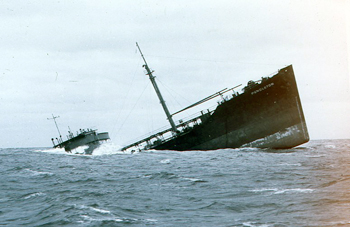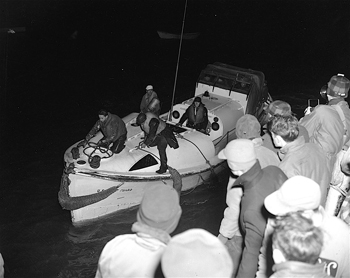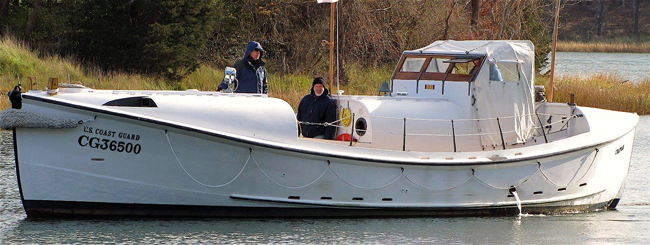The Daring Rescue of the
Pendleton Crew
by Tom Seymour

The fore half of the SS Pendleton going down off Chatham ,MA. with 8 crew members. The survivors on the aft half were rescued in white-out conditions in a winter storm on a night in 1952. The William Brewster Nickerson Cape Cod History Archives, Wilkens Library Cape Cod Community College photo.
SS Pendleton, a Type T2-SE-A1 tanker, was built in 1944 for the United States Marine Commission. But Pendleton and all other T2 tanker ships had a serious flaw. They were likely to split in two in very cold weather. During World War II, Pendleton sailed in a convoy out of Liverpool, England and arrived in New York on September 2, 1944.
After the war, the Pendleton was sold to National Bulk Carriers, where she remained in service until February, 1952, when the oil-laden vessel broke up in a fierce storm. But that was not the first time Pendleton encountered problems. In July of 1951, Pendleton ran aground in New York’s Hudson River, damaging a section of her hull. The vessel was refloated the following day.
She was beset by
hurricane-force winds,
driving snow, sleet
and gigantic waves.
The Pendleton measured 504 feet long, was 68 feet, 2 inches at the beam and had a depth of 39 feet, 2 inches. Pendleton was a “turbo-electric” vessel, meaning that a steam turbine drove a generator and the generator, in turn, supplied electricity to power a motor that drove the propeller shaft. This arrangement allowed the vessel to sail at a top speed of 16 knots.
The Pendleton had left Baton Rouge for Boston and at 5 a.m. on February 18, 1952, the vessel was 10 miles out from Chatham, Massachusetts, fighting a fierce, raging snowstorm and 60-foot waves. According to an article in the New England Historical Society newsletter, the crew heard, “explosive cracking noises.” The vessel lurched violently and with that, broke in two.
After The Breakup

U.S. Coast Guard CG36500 approaching fishermen’s wharf at Old Harbor, Chatham, in MA February 1952. Aboard were 32 crew members of the SS Pendleton which broke in half off Chatham in a snow storm. The William Brewster Nickerson Cape Cod History Archives, Wilkens Library Cape Cod Community College photo.
The two halves of the vessel remained afloat. The bow section had lost power and helpless, was driven south with the captain and seven crew members aboard. The stern section fared slightly better, retaining power. The chief engineer assumed command and assigned different duties to the 32 crewmen on board. However, those stranded on the Pendleton were unable to issue an SOS signal.
At the same time the crew of the Pendleton was struggling to survive, another vessel, the Fort Mercer, this one 20 miles off the coast, had also snapped in two in the monstrous waves. The Chatham Lifeboat Station sent out cutters, an airplane and a motorboat in search of the stricken vessel.
Several hours later, according to the New England Historical Society, the Coast Guard station’s radar picked up the broken pieces of the Pendleton. So despite not being able to issue an SOS, the crew’s fate still became known to authorities by way of modern technology.
The Mission
According to a February 18, 2019 article by Walter Brooks in CapeCodToday, Coast Guard rescue boat CG-36500, a rescue boat designed to hold no more than 16 people, left the Chatham fishing pier, headed to the foundering Pendleton.
Myers jumped prematurely
and a huge wave slammed
CG-36500 against the
Pendleton, crushing
him instantly.
Coxswain Bernard Webber was directed to form a crew to attempt the rescue of those stranded on the Pendleton. This was considered a suicide mission, yet Andrew Fitzgerald, Richard Livesey and Irving Maske, quickly volunteered. As CG-36500 set out on her suicidal mission, she was beset by hurricane-force winds, driving snow, sleet and gigantic waves. Her only navigation accessories were a compass and a spotlight.
Nearing the Pendleton, CG-36500 was compelled to cross Chatham’s dangerous sandbar. The crew sang “Rock of Ages” and “Harbor Lights” in order to calm their tense nerves during the treacherous crossing. As the vessel crossed the bar, a giant wave smashed into her, heaving the vessel high into the air. The CG-36500 landed on its side, but was able to right itself just before another mountainous wave struck. This second wave shattered the windshield, sending glass shards into Coxswain Webber’s face. It also destroyed the boat’s compass, their sole navigational aid.
When CG-36500 arrived off the Pendleton’s stern the Pendleton crew lowered a Jacob’s ladder over the side and began the ascent to safety. A Jacobs ladder is a rope ladder made with wooden steps that extend well past both sides of the ropes. This is to keep the ladder from twisting and possibly trapping a person between the ladder and the ship. In use, hands grasp the vertical ropes and feet skip one step at a time. Hand and leg on the same side move together. Properly termed, a nautical Jacobs ladder is spelled without the apostrophe.
Most of the Pendleton crewmen jumped from the ladder to the rescue boat, while others were hurled into the sea and were pulled to safety by the Coast Guardsmen. One of Pendleton’s crew fell into the sea and was immediately crushed between the hull of the rescue boat and the hull of the Pendleton. George, “tiny” Myers had remained aboard, helping his fellows onto the ladder. But instead of being the last man rescued, Myers jumped prematurely and a huge wave slammed CG-36500 against Pendleton, crushing him instantly. According to CapeCodToday the rescuers later said that Myer’s death troubled them for years after.
According to the Department of Homeland Security United States Coast Guard Auxiliary, “Coxswain Webber backed his small craft’s engine hard, but the boat smashed into Pendleton and Tiny Myers. The CG-36500 was ejected from underneath the Pendleton by another large wave just as the hulk was lifted one last time and rolled over and sank.
He determined that
either they would
“all live together or
die together.”
“All was again dark as the CG-36500’s searchlight was extinguished. Coxswain Webber was sick at the thought of losing Tiny Myers, but knew the fate of the 36 men on his small boat rested exclusively in his hands. Lost with no compass to steer by and with zero visibility conditions, there were just two choices. Head east into the seas and hope to survive 10-12 more hours until a new day’s light brought the slim chance of transferring passengers yet again to a larger rescue ship. Or, put the wind and seas on the small boat’s stern and let them force the vessel ashore someplace where help might be nearby.
“Coxswain Webber tried his radio again and received an immediate acknowledgement. Once he briefed his superior that he had 32 Pendleton survivors aboard, there ensued a squabble between the nearby CG cutter McCulloch and the Chatham Lifeboat Station about various operations. These included a suggestion of an at-sea rendezvous with McCulloch and a second transfer of survivors! The radio was quickly turned off and Webber devised a plan to beach the CG-36500 at first opportunity. The small vessel would be held on the beach as long as possible with the engine while the survivors clambered ashore. On cue, the Pendleton crew gave a cheer of approval and support and on they went. Very soon, a red flashing light appeared! And, the boat’s searchlight incredibly revealed the buoy that marked the turn to the entrance to Old Harbor, Chatham and safe water.”
One of the memorable incidents of the rescue occurred when, after 20 crewmen found safety on CG-36500, the wooden motorboat began to respond sluggishly. Coxswain Webber was certain the vessel couldn’t make the return trip with any more persons aboard. But he determined that either they would “all live together or die together” and continued taking on crewmen from the stricken Pendleton. And so the overloaded CG-36500 pounded her sluggish way back to Chatham, the Nor’easter still pummeling and pelting her.

U.S. Coast Guard CG36500 used in the rescue of Pendleton crew members after a restoration that began in 1981 by the Orleans Historical Society. The 36' wooden vessel was an official U.S. Coast Guard Motor Lifeboat built in 1946 in Maryland. Orleans Historical Society photo.
In Chatham, local residents, having heard the story unfolding on the radio, were at hand to assist the survivors as they made their way into the warmth of the rescue station.
In all, the Coast Guard rescued 32 of the 33 men trapped on Pendleton’s stern and all were taken safely to Chatham. The eight souls aboard the bow section perished and their bodies were never recovered.
A similar situation developed with the Fort Mercer. Coast Guard cutters were unable to rescue the five sailors trapped in the bow. Their bodies were never recovered. But 38 men trapped on the stern were rescued.
Aftermath
According to the New England Historical Society, a later investigation determined that the steel used in wartime construction of both tankers had a dangerously high Sulphur content. This caused the steel to become brittle in cold conditions.
Regarding the heroic rescuers, Rear admiral H.G. Bradbury congratulated the crewmembers for, “outstanding seamanship and utter disregard of your own safety in crossing the hazardous waters of Chatham Bar in mountainous seas, extreme darkness and falling snow during a violent winter gale to rescue from imminent death thirty-two crewmembers…minutes before the tanker capsized.”
BMI Bernard C. Webber, USCG of Chatham, Massachusetts, and his three volunteer crew members all received the Treasury Department’s coveted Gold Lifesaving Medal for “extreme and heroic daring” during the Pendleton rescue.
In 2016, Disney released the movie, “The Finest Hours,” starring Chris Pine, Casey Affleck, Ben Foster, Eric Bana, based on the book, “The Finest Hours” by Michael J. Tougias.
Watch “The Finest Hours” trailer here.
